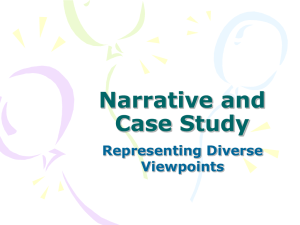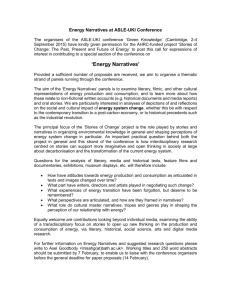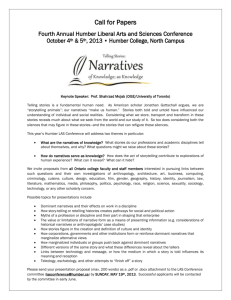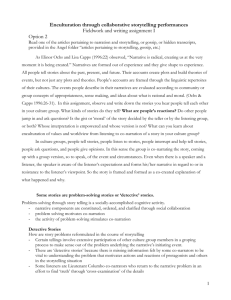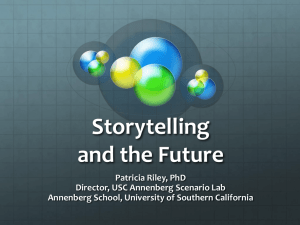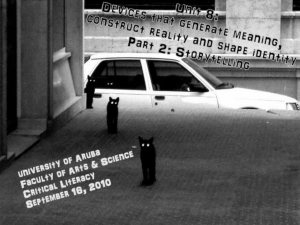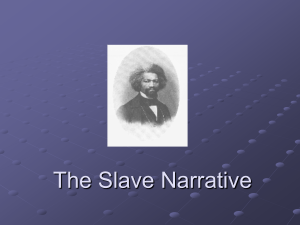Session III PowerPoint–Narrative and Storytelling
advertisement
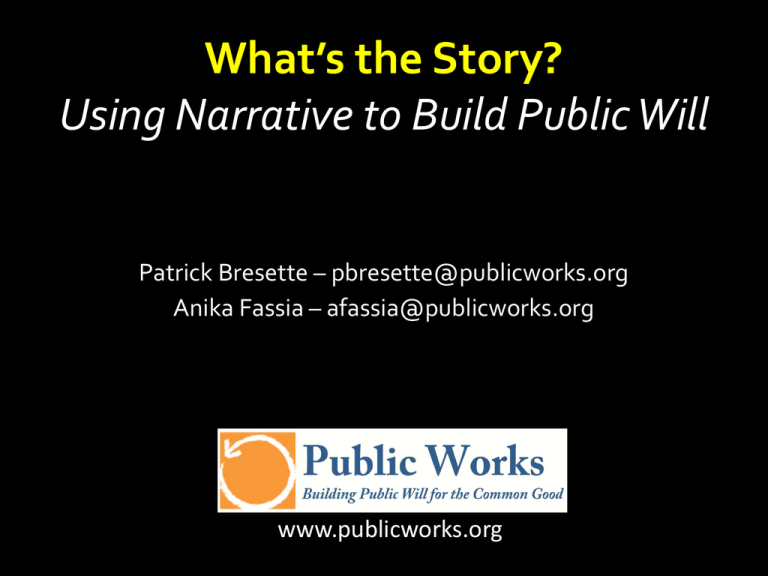
What’s the Story? Using Narrative to Build Public Will Patrick Bresette – pbresette@publicworks.org Anika Fassia – afassia@publicworks.org www.publicworks.org Narratives that resonate can connect and persuade . . . If you want to build a ship, don't drum up people together to collect wood and don't assign them tasks and work, but rather teach them to long for the endless immensity of the sea. — Antoine de Saint-Exupery Narratives vs. Stories “Stories and narratives are often used interchangeably, as synonyms. But here I will draw a crucial distinction between the two. Narratives are stories that do not end – they persist indefinitely. They invite, even demand, action by participants and they reach out to embrace as many participants as possible. They are continuously unfolding, being shaped and filled in by the participants . . . Stories are about plots and action while narratives are about people and potential.” -John Hagel Building Blocks of Narrative • The frames we use and evoke • The elements and tools of good storytelling • Awareness of competing cultural models, stories, myths and parables • Tapping into shared values, shared hopes • A “common sense” description of problems and solutions our brains are rapidly seeking to connect new information to the existing stories in our heads Communications is Storytelling Storytelling is as old as humankind yet as new as this morning's news headlines. “Analysis might excite the mind, but it hardly offers a route to the heart. And that’s where we must go if e are to motivate people not only to take action but to do with energy and enthusiasm.” - Stephen Denning Stories “They are the narratives of life, spanning the centuries and connecting the generations. They are the vessels in which we carry our history and traditions, our values and lessons for living, our hopes and dreams.” Cultural The International Storytelling Center, TN Stories All evidence leads to the conclusion that concepts conveyed in story form — more than ideas explained with logic and analysis — imprint themselves naturally in human minds.” Cognitive - Roche and Sadowsky Master Narratives Whenever we engage in public debates we may think of ourselves as conduits of information. However, our audiences think about those same policies, issues, and programs in terms of the background story— the master narrative —that lies beneath our bullet-points, facts, statistics, and legal citations. The American Dream “ . . . life should be better and richer and fuller for everyone, with opportunity for each according to ability or achievement . . . regardless of the fortuitous circumstances of birth or position . . . - James Truslow Adams, 1931 Narratives need . . . aspiration, not desperation Aspiration Chicken Little Desperation New Mexico Land that used to be Enchanting New Mexico – Land of Enchantment The wild lands of New Mexico have been the source of our spirit and culture for a thousand years. We have a legacy of living with the land, not just on it. A new century poses new challenges – balancing growth and prosperity with the open space that is our heritage. The Wilderness Alliance is working to keep this balance and ensure that New Mexico remains enchanting for future generations . . . What’s Wrong Why it Matters What Can be Done What Can be Done Why it Matters What’s Wrong Families without housing face a staggering number of obstacles. Children can suffer from poor academic performance, have higher rates of asthma, ear infections, stomach problems, and speech problems, and are at higher risk of mental and physical trauma. Parents struggling with housing security find it difficult to get and keep a job, pursue educational goals, and provide adequate care and attention to their families. By creating opportunities for families to build economic and housing security, families can build better lives and our communities will be stronger. We know that communities are stronger and healthier when at-risk families get the help they need to find and stay in safe, affordable housing. As a result, families improve their children’s education, find stable employment, and have a deeper sense of belonging in their neighborhood. It is for this reason that the public sector should work with nonprofit organizations and private funders to give every family the opportunity to have a safe and stable home. Chicken Little and Global Warming "Our study indicates that the potentially devastating consequences of global warming threaten people's fundamental tendency to see the world as safe, stable and fair. . . ," said Robb Willer, UC Berkeley social psychologist . "The scarier the message, the more people who are committed to viewing the world as fundamentally stable and fair are motivated to deny it," agreed Matthew Feinberg, Overall, the study concludes, "Fearbased appeals, especially when not coupled with a clear solution, can backfire and undermine the intended effects of messages." Remember – Order Matters! Once a frame is triggered it crowds out all other frames Moving from aspiration, to desperation Portrait Landscape Public or Private Responsibility? “The use of either the episodic [portraits] or the thematic [landscapes] news frame affects how individuals assign responsibility for political issues; episodic framing tends to elicit individualistic rather than societal attributions of responsibility while thematic framing has the opposite effect. Since television news is heavily episodic, its effect is generally to induce attributions of responsibility to individual victims or perpetrators rather than to broad social forces.” (Iyengar, 1991) Different Stories > Different Solutions • • • • • • Portraits Individuals Events Private Appeal to consumers Better information Fix the person • • • • • • Landscapes Issues Trends Public Appeal to citizens Better Policies Fix the Condition - Based on work by Iyengar and Gilliam Personal Stories are Not Thematic Stories Graeme Frost – Poster Child for SCHIP . Time Magazine, October 10, 2007 Dennis Brack / Bloomberg News / Landov Turned into a Category 5 Hurricane in the blogosphere - Time Magazine, Oct 10, 2007. “the Swift-boating of Graeme Frost” "Maybe Dad should drop his woodworking hobby and get a real job that offers health insurance rather than making people like me (also with 4 kids in a 600sf smaller house and tuition $16,000 less per kid and no commercial property ownership) pay for it in my taxes." -- blogger calling himself Icwhatudo From Portraits to Landscapes Personal stories are told more often and are easier to tell than stories that illustrate the systems and structures that perpetuate inequality. Stories of individual change are at the core of our culture and they engage us. Stories of collective action are there as well but told less often. With practice, advocates can identify the conditions they want to illustrate and better link those descriptions to the particular policy debate and values they hold. - Larry Wallack Ripple Effects Music Teacher Mom able to go to work consistently Kids involved in afterschool activities Employer Family finds safe & affordable housing Kids stable in school Mom’s stress decreases, health improves Teacher Resident Services Staff Referral to SNAP Doctor, Nurse Music Teacher Kids get involved in afterschool activities Mom able to go to work consistently with reliable transportation Employer Family receives EITC refund Family remains stable in housing Mom’s stress decreases, health improves Landlord Tax Preparer Family able to save $ for emergencies Doctor, Nurse Teacher Mom & Dad are closer to their jobs Kids get involved in afterschool activities Employer Through the IDA Initiative, a new Home is purchased Family gains a new community Mom’s stress decreases, health improves Neighbor IDA Program Staff Family creates emergency fund. Doctor, Nurse Messengers • The choice of messengers is as important as the message itself. • The message is reinforced or undermined by the choice of messenger. • Knowledge and trustworthiness, not likeability or familiarity. • Some messengers are not credible we assume they are biased toward a perspective. • Unlikely allies can prompt public reconsideration recommendation. • Some messengers convey specific frames. • - FrameWorks Institute What are the “Ripple Effects” of your work? Narrative allows us to communicate the emotional content of our values. Narrative is not talking “about” values; rather narrative embodies and communicates those values. And it is through the shared experience of our values that we can engage with others, motivate one another to act, and find the courage to take risks, explore possibility and face the challenges we must face. - Marshall Ganz, Kennedy School, 2007 www.publicworks.org

